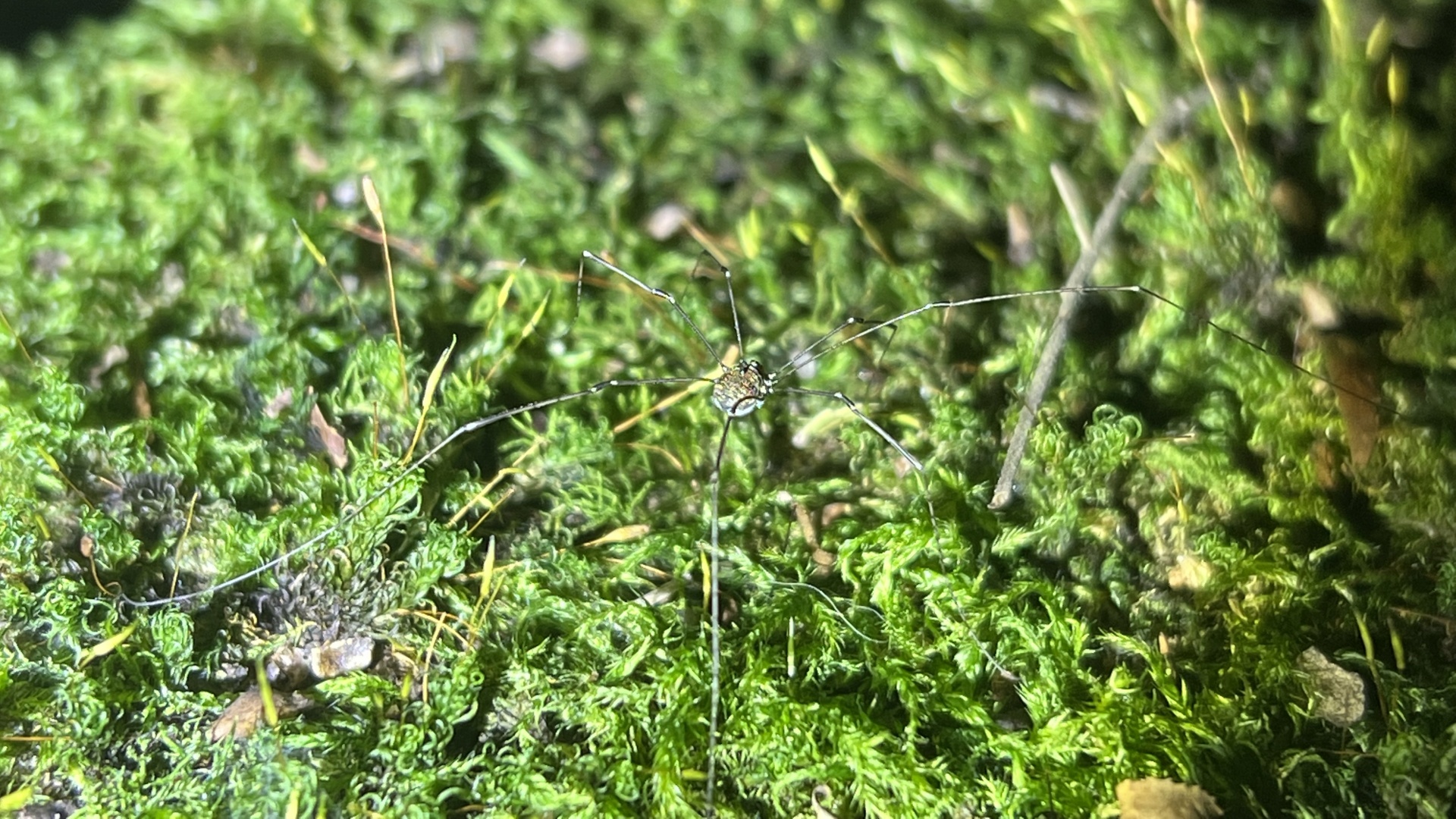Harvestmen (Opiliones): Self-Amputation When Threatened, Limbs Cannot Regenerate
Updated:2024-12-18 Source:Shennongjia National Park
In the sultry summer, rain often falls in abundance. Around midnight, as the rain ceases, a gentle breeze flows through the forests of the Shennongjia region. Before long, the dew on the leaves of the shrubs has dried. A tiny oval-shaped creature, suspended between its eight slender legs, slowly crawls onto a leaf. Its front legs, resembling probing canes, tap here and there—tap-tap, tap-tap-tap—taking one, two, or three steps at a leisurely pace, as if blindly feeling its way forward. This slow-moving small arthropod is a Harvestman. Fascinatingly, harvestmen have even made their way into films; the Susuwatari (ススワタリ), or soot sprites, in Spirited Away were inspired by these creatures.

It's worth clarifying that harvestmen are not spiders. In terms of phylogeny, they are actually more closely related to scorpions. And harvestmen are not truly blind. They do have eyes—two, to be exact—but their vision is quite poor, and the placement of their eyes is rather peculiar. The head and body of a harvestman are fused into a single structure, resembling an oval. On the back of this oval body is a small rounded bump, with two prominent eyes positioned almost at the highest point of their back. Unlike spiders, harvestmen do not spin webs and have no venom. In the animal kingdom, they occupy the lower rungs of the food chain, subsisting as scavengers. They feed on whatever insect carcasses they come across; if none are available, they simply go hungry. After rain, harvestmen become especially active, as many small insects are knocked down and killed by raindrops, providing these opportunistic creatures with a veritable feast.
Harvestmen are ancient creatures, with fossils dating back nearly 400 million years, discovered in the UK. More than 6,500 species of harvestmen are known worldwide. They are more commonly found in tropical regions, with fewer species in temperate zones. Harvestmen are frequently found in Shennongjia, where they thrive in damp environments, living in grass, dead wood, moss layers, wall corners, soil, crevices, and caves.
Male harvestmen have a penis, which is worth noting because male spiders do not have one. Female harvestmen have an ovipositor, which is concealed within the abdomen and extends from the genital opening during mating or egg-laying. Fertilized eggs are deposited in the soil, decaying wood, plants, or snail shells. Some species of harvestmen are capable of parthenogenesis, meaning they can reproduce without the need for a male. In this process, the female reproduces by copying her own DNA, allowing the eggs to develop into normal new individuals without fertilization.
The most distinctive feature of harvestmen is their long, slender legs. While their bodies are only about 5 millimeters in size, their legs can reach up to 10 centimeters—over ten times their body length. Even with eight legs supporting their body, one might worry it could fall off. However, such concerns are unnecessary. In fact, only six of their legs are used for walking: three legs form a stable triangular base, while the other three move forward, alternating continuously. They can change direction effortlessly, navigating leaves and rock walls with ease. Notably, the second pair of legs is especially long and used for exploring their surroundings, functioning like eyes to compensate for their poor vision.
Although harvestmen usually move at a slow pace, they can run surprisingly fast in emergencies. Their legs serve not only for walking but also for defense—though not by fighting. Instead, they practice self-amputation, detaching a leg that can twitch for up to half an hour to confuse predators. It’s worth noting that harvestmen cannot regenerate lost legs, which is why it’s rare to see one with all its limbs intact. Moreover, harvestmen are highly dependent on water; when dehydrated, their long legs curl up, and they quickly succumb to the lack of moisture.
Most notably, this long-legged species tends to cluster together on the sheltered sides of rocks, which serves as another defensive strategy. Thousands of harvestmen gather in one spot, their legs as fine as strands of hair, covering the entire rock surface. Such a mass of legs can bewilder predators, leaving them unsure where to strike.(Written by Shuiyi Photo by Li Chenliang) Copyright Shennongjia National Park
Address:36 Chulin Road, Muyu Town, Shennongjia Forestry District, Hubei Province 鄂ICP备18005077号-3
Address:36 Chulin Road, Muyu Town, Shennongjia Forestry District, Hubei Province 鄂ICP备18005077号-3
Email:2673990569@qq.com
Phone:0719-3453368
Phone:0719-3453368


TOP

